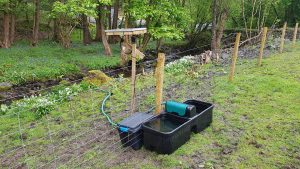What is a Papa Pump?
12 June, 2024
by Rachael Halhead
Fencing
One of the initiatives South Cumbria Rivers Trust delivers is protecting rivers through watercourse fencing. Fencing offers several advantages including safeguarding livestock by preventing them from accessing steep banks, reducing poaching next to the river, which reduces the amount of fine sediment entering a watercourse. The space between the fence and the river becomes a buffer strip and can be utilised for planting trees or maintaining natural vegetation. Crucially, this space absorbs surplus surface run-off, contributes significantly to improving water quality and enhancing riparian biodiversity.

An example of a solar powered trough installation.
One of the major challenges when fencing rivers is ensuring safe livestock have safe access to water. Here at SCRT we address this in different ways. 1) Create a secure drinking watering point directly into the river. This ensures suitable bank gradient for single-point access, minimising the length of river section susceptible to bank poaching. 2) The installation of a solar-powered drinking trough. However, dependent on the site, these options may not be feasible. So what other options are there?
The solution
We recently had the opportunity to trial an exciting new solution on a site with challenging terrain, extremely steep riverbanks and a nearby public footpath. It was the installation of a Papa Pump.
A Papa Pump allows the farmer/landowner to gain access to water without the use of fuel or electricity making it efficient and convenient. Instead, it uses the natural power of flowing water which allows water to be pumped up and over longer distances.
How does it work?
The pumps work on the principle of hydraulic pressure. To feed the pump water it relies on gravity of the water source at higher elevations. As the water enters, the pump valves close quickly. This process continues with the valves opening and closing at a rapid rate, which forms pressure allowing for the lift and the water to be pumped up hill to where it is needed.
This means we can install no-energy, long lasting water supplies for livestock that will help to keep the rivers healthier for wildlife and safer for livestock.
We are monitoring the pump and asking the landowner for feedback about how well it is performing. We hope this trial will lead to more pump installations in the future in those more difficult to reach areas, within our catchment areas.

